
Male and Female Skeleton
Additional chapters in This Section include:
Gender Reassignment Surgery
Orchiectomy for MTF Transsexual Women
FFS Facial Feminization Surgery
MTF Transsexual Surgeries
Hormone Replacement Therapy for Transgender Women
Female Hormone Therapy MTF Transsexuals
Breast Development in MTF Transsexuals
MTF Transsexual Breast Enlargement
Breast Augmentation MTF Transsexuals
Lactation and the Transsexual Woman
Injecting Silicone for Transsexual Women
Brazilian Hips and Buttock Enlargement
Average Body Size MTF Transgender
Male and Female Skeleton Transsexuals
Treatment of Young Transsexuals
Puberty in Adolescents MTF Transgender
Treatment of Young MTF Transsexuals
Treatment of Intersex Infants
Androgen Insensitivity Syndrome
Female Physical Beauty Transgender
Transgender Female Beauty
Exercise, Fitness and Diet for Transsexual Women
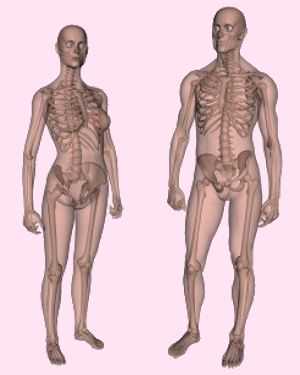
[This article should be read in conjunction with the article on |
Average Body Size
.
I also apologise for the unavoidable plethora of medical names.]
|
One of the distinctions between a genetic man and a genetic woman is the characteristics of their skeleton. The skeleton obviously sets or heavily influences the
|
body size
and its proportions.
|

|
|
Jessica is a very beautiful woman, but a close inspection reveals male skeletal characteristics.
|
It's thought that genes (usually female "XX" or male "XY") mainly determine the basic size and shape of the skeleton, however some differences are exaggerated or emphasised at puberty by the sex hormones that surge around the growing body. The high levels of testosterone that appear in boys at puberty help lengthen and rugged'ise their still developing bones, enhancing and developing male skeletal characteristics such greater height and narrower pelvic width. The near absence in girls of these hormones prevents such skeletal developments; indeed the presence of high levels of estrogen in a pubertal girl probably helps stimulate the growth and shape of her pelvic bones, but otherwise actually act to limit bone growth and final adult height. [Appropriate hormonal treatment in a
young transsexual
can thus have substantial benefits in terms of skeletal development, benefits not obtainable after puberty when bone development is essentially complete].
Despite the sex related differences, overall the differences between the skeletons of male and female bodies are actually surprisingly small compared with the similarities, as is illustrated by comparing the following diagrams:
|
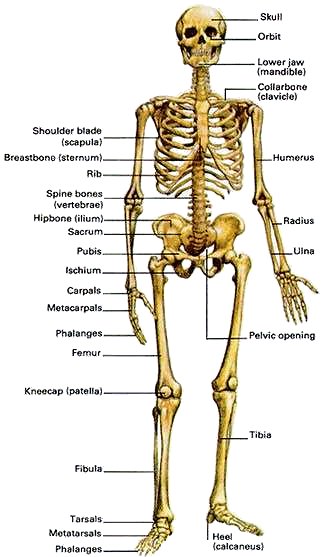
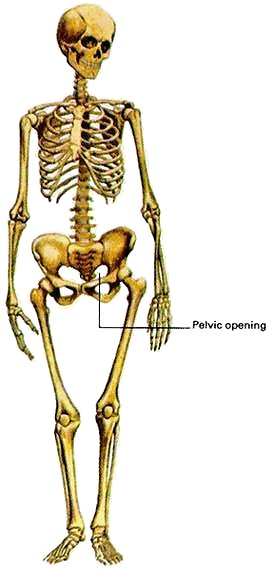
A baby's skeleton has 350 bones, but many of these fuse to give an adult a total of 206 bones. A man's skeleton has broader shoulders than a woman's, a longer ribcage, and a pelvic girdle optimised for walking/running.
|
A woman's skeleton has the same bone complement as a man's but is slightly smaller and less robust, with a wider pelvic opening to assist childbirth.
|
Skeletal Sex Differentiation
|
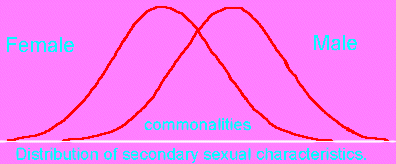
It is actually quite difficult to distinguish between male and female skeletons as there is a clear range of overlap between the sexes for many measures. Indeed, there is in fact no certain, 100% guaranteed, method of telling the sex of a skeleton from simple examination and inspection alone, as criminologists who have misidentified the sex of murder victims, and archaeologists who have been unable to determine from skeleton X-Rays whether Egyptian Pharaoh Tutankhamen was actually male or female, can confirm.
|

The physical similarity of "super models" such as Gisele Bundchen (left) to transsexuals such as Caroline Cossey has caused speculation and highlights the overlap in human sexual differentiation.
|
On average a male skeleton is larger than the female skeleton so this is a differentiation, but there is also a considerable overlap in skeletal size between the sexes - e.g. there are short men and tall women - so this is hardly a reliable method alone. Other significant differences between male and female skeletons are that female bones are usually lighter and thinner than more robust male bones; female head bones are smaller and more lightly built; and the female pelvis is shallower and wider than the male's. This latter difference makes childbirth easier. The pelvis is considered to be the best area to determine or estimate the sex of a skeleton, while the skull (cranium and mandible) and post-cranial skeleton is the second best area.
|
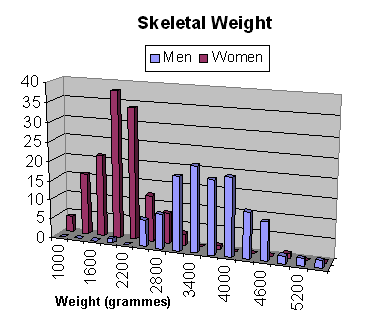
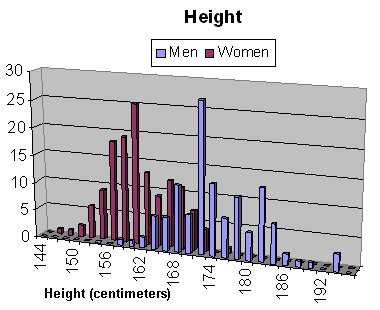 Measurements of weight and height have little overlap between male and female skeletons, and thus can distinguish between men and women with a 90% success rate. Transsexual women would generally be identified as men on these criteria. (Sample sets of 125 men and 138 women are illustrated)
Measurements of weight and height have little overlap between male and female skeletons, and thus can distinguish between men and women with a 90% success rate. Transsexual women would generally be identified as men on these criteria. (Sample sets of 125 men and 138 women are illustrated)
Skull and bone features vary from male to female - differentiation is usually based on the generalization that "typical male" features are more pronounced and marked than the same features in a female. By observing all the possible differentiating features of skeleton in a cumulative manner, it's possible to correctly identify the sex of a Caucasoid skeleton in about 90% of cases. [Krogman ranks accuracy of sex determination using the pelvis at 95%, followed by the skull at 92%, the mandible alone at 90%, and long bone measures at 80%. Stewart indicates slightly lower yields, however the order of accuracy was the same, with the long bones again the least accurate.] Success rates are somewhat lower for Negroid and Mongoloid skeletons.
Note that it is often impossible to place absolute metric value on what constitutes a male feature, and what constitutes a female. Krogman addressed the difficulty of sex determination from skeletons when he stated: "here is the problem of subjectivity versus objectivity, of description versus measurement, of ‘experience’ versus statistical ‘standardization.’ "
Skull
The adult female skull retains gracile attributes seen in the pre-pubescent skull, but the male cranium becomes markedly rougher in adulthood at the sites of muscle attachment.
|
Major differences between the female and male skill include the posterior of the cranium (the occipital), robusticity of the browridge, mastoid process, nuchal crest, temporal lines, and mandible. Although distinct, the ability to quantify measures of the skull for sex determination has met with limited success and successful sex identification based purely on a skull is a very subjective process based experience in identifying and assessing non-metric characteristics.
|


Phenotypic male and female faces. Notice the man's square face, heavy brow, prow nose, bigger jaw, and the woman's lighter build, triangular shape, high vertical forehead, no browridges, small nose, pointed chin.
|
Above the orbits (eye sockets), the male cranium tends to have "blunt" superior margins and larger supraorbital (brow) ridges. The female cranium tends to have "sharp" superior margins of the orbits and no discernible supraorbital ridges.
|
The occipital of males tend to have a well-defined nuchal crest. In some cases, the nuchal crest and nuchal line are very rugged and sharp. In very gracile females, there is almost no nuchal crest and the nuchal line is completely absent.
|
The mandible of a female cranium tends to have a "pointed" chin. The area around the genial angle is smooth and does not project. The male mandible tends to have a "square" shape and in extreme case the area around the genial angle is "flared". The dentition (teeth) of males is frequently larger.
|
Finally, the area of the temporal in the female cranium is smoother and less rugged than that of the male cranium. In the female cranium the zygomatic arch normally does not extend, as a ridge, posterior of the external auditory meatus. In male crania the zygomatic arch typically extends, as a ridge, posterior to the external auditory meatus. In females the mastoid process is small and smooth. In males the mastoid process is large and rugged.

Male and Female Cranium Differences
|
Most important skull differences between men and women are indicated by the letter value on the figure to the left and described below:
|
A) The mans cranial mass is more blocky and massive compared to the females which is rounder and tapers at the top.
B) Temporal Ridge - runs along the outer side of the upper skull creating the square shaped of the upper head. More prominent in men than women.
C) A woman's supraorbital margin (the ridge above the eyes) is sharper, while the males is rather round and dull.
D) The Zygomatic bone (the cheekbone that lies under the lower eye ridge) is more pronounced on the male skull.
E) The Mandible (lower jaw) bone of a woman is rounded, while the male's is squared.
F) Frontal bone – forehead structure terminates at the brow. The male forehead is lower and more slopping.
G) Men have a deeper cranial mass.
H) The supercilary arch is large and pronounced in the man.
I) A males gonion (most posterior inferior point on angle of mandible) is more flared out and sharply angled.
J) The teeth of men tend to be larger.
|
Here is a summary of the differential criteria between the male and female cranium bones:
|
Cranium Feature
|
|
Male
|
Female
|
|
Frontal bone (forehead)
|
lower and sloping
|
more vertical and rounded
|
Temporal Ridge
|
large
|
small
|
Bony superciliary arches (browridges)
|
prominent
|
absent or slight
|
Mastoid process (bone behind the ear)
|
large
|
small *
|
Supraorbital margin (ridge above eye)
|
rounded
|
sharp
|
External occipital protuberance (protrusion on lower back of the cranium)
|
generally present
|
generally absent
|
Nuchal crest (low ridge along the back base of the cranium)
|
rugged
|
smoother, even absent
|
Zygomatic process (cheek bones)
|
extends past external
|
does not *
|
Mandible (jaw)
|
larger and more robust
|
smaller and lighter
|
Symphysis and mental eminence of mandible (chin)
|
square
|
rounded *
|
Ramus of mandible (back of jaw bone)
|
straight
|
slanting
|
Mandible gonion and gonion angle (back corner of jaw bone)
|
flaring and sharply angled
|
less so
|
Sinuses (air ways)
|
larger
|
smaller
|
Teeth
|
larger
|
smaller
|
Cranium
|
deeper and larger by about 10%
|
smaller
|
Total skull
|
heavier, rougher
|
more rounded, smoother
|
*These may vary. Exceptions occur frequently.
|
|

Face
Its worth relating the skull differences just described to the face. Unfortunately for the transsexual woman, the human eye and brain is amazingly able to distinguish between a "male" face and a "female" face on the basis of very minor differentiations and indications.
|
However, as ever, there is great variance - many handsome actors on close examination have some feminine facial characteristics, while many supermodels have some very male characteristics.
|
In absolute measures almost all dimensions of the female skull and face are smaller compared to the male features. The facial width is relatively larger in women than in men. Resulting contours are therefore more rounded in females, especially in the orbital area, with more prominent molar (cheek) bones and less prominent mandibular (chin/jaw) angles.
Forehead
In the upper part of the face, the forehead is quite different, most noticeably women have less sloping mid-foreheads and the position of their eyebrows is higher and has a stronger curvature.
|
Nose
In the middle part of the face, the angles of the nose differ substantially, especially at the tip portion. Females generally have a more pointed, narrow, and vertically shortened less nasal prominence than males.
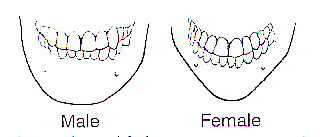
Chin
In the lower part of the face the most dominant differences are found in the chin region, which varies markedly between the male and female. The male chin is larger in every dimension, the maniple symphysis (upper chin) is generally wide and vertically high, while the female is more rounded, and the male mental eminence (point of the chin) tends to be square and the female more pointed. The degree of perceived masculinity/femininity due to the chin can vary tremendously.
|

A woman's figure would seem to be an obvious male/female differentiator - but it's not, even with top models, due to the wide diversity. Many teenage boys technically have a better figure than their sister!
|
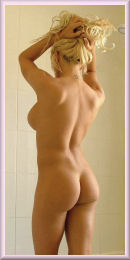
An attractive girl, but she is a XY transsexual and her skeleton -including her pelvis - reflects this past. Only the pre-puberty taking hormones can materially affect the skeleton, and that is very rare other than for
intersex
children.
Exaggerated images of female and male lower torso's are shown below.
|
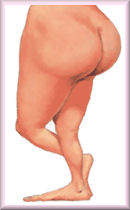
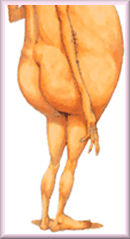
Supposedly ideal female proportions have been mathematically calculated:
|
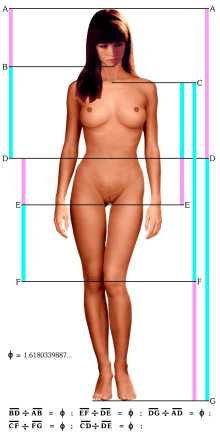
Pelvis
The pelvic girdle is formed by the sacrum, coccyx, and the two coxae. A coxa is formed by the fusion of three bones, the ilium, ischium, and pubis, which meet in the acetabulum or hip socket. At the back each coxa is attached by strong ligaments to the sacrum (base of spinal cord), and in front to each other at the pubic symphysis joint. This joint allows only slight bending movement, but it softens and becomes more flexible in a female giving birth. [Note: Other names for the pelvic bone are innominate bone and coxal bone.]
Physical Sex Differences
The following sex differences are true for the hypothetical "average" male and female.
|
Genitals and Functions
Males have penises and testes; females have vaginas and wombs.
|
Form
Males and females differ in form. Their curves and angles. or their shapes are different, generally and relatively. Females generally have a more roundish look because their subcutaneous fat covers and hides their muscles. Men do not have women's characteristic layers of fat beneath their skin, and therefore their appearance is more roughish because their muscle tissues show through their skin more so than females.
|
Head Features
Women's eyes are set further apart than men's. Women's eye brow is lighter than men's in appearance. Looking toward the front, women's face is rounder, broader than men's. Looking from the top down on the head, women's head is rounder, while men's head is longer from front to back.
|
Breasts and Shoulders
Women have developed breasts with larger nipples and areolas than men. Women's shoulders are more narrow, rounded, and sloping than men's.
|
Angle of Arms and Legs
The angle of women's thigh and lower leg gives a "knock-knee" effect to females, while men's form a straight line. Also women's arms form a bent "carrying angle" at the elbow, while men's "carrying angle" is straight.
|
Hips and Legs
Looking towards the front, women's hips are wider than men's, and their hips have a more round'ish curve than men's. Women's legs have a conical shape, while men's legs have a cylindrical look.
|
Hands and Feet
Women's hands and feet are relatively smaller, narrower, and more delicate looking than men's.
|
Hair
Women do not have noticeable hair like men on their chest, arms, legs and other bodily areas. Women's pubic hair is formed like a triangle pointing down; men's pubic hair forms a triangle pointing up. Women do not loose head hair like many men do in old age.
|
Dimensions
Women are generally smaller and more delicate than men. The following apply generally for those of western European descent:
|
Height
By age 20 years, women are generally 10 percent shorter than men.
|
Weight
By age 20, women are generally 20 percent lighter than men.
|
Strength
Adult men are generally 50 to 60 percent stronger than women.
|
Factors contributing to the overall shape of the pelvis are constrained by both the demands of bipedal locomotion, as well as those for perpetuating the species. Of all the bones, the pelvis shows the greatest sexual differentiation, principally in relation to the requirements of childbirth. On average the male pelvis is much heavier and narrower than that of the female. In comparison the female pelvis is broad and shallow, the geometry is designed with a greater outlet for passage through its bony openings of a baby's head and shoulders during birth. The female pelvis is also less massive and more delicate and its muscular impressions are slightly marked.
In the female pelvis the ilia are less sloped, and the anterior iliac spines more widely separated; hence the greater lateral prominence of the hips. The pelvic inlet of females is larger and has a greater absolute circumference. The body of the pubis is longer, thereby increasing the size of the pelvic outlet. The size of the pelvis varies not only in the two sexes, but also in different members of the same sex, and does not appear to be influenced in any way by the height of the individual. Women of short stature, as a rule, have broad pelvises. The characteristic differences between the male and female pelvis are distinctly indicated as early as the fourth month of fetal life.
In the female, the superior ramus of the pubic bone is longer, increasing the pubic/ischium ratio. The greater sciatic notch is wider and forms a longer angle. The increased pubic length and laterally displaced ischia result in a wider subpubic angle. The growth and remodeling of the pubis produces extra bone at the symphysis, leaving a concave inferior ramus, a ventral arc that represents a previous border of the symphysis, and a narrow inferior pubic ramus. The female pubic symphysis is likely to be longer in its superior-inferior diameter and smaller in its dorsal-ventral diameters than is that of a male. Females are more likely to have a well-developed preauricular sulcus, and those who have borne children may have pits or guttering along the dorsal border of the pubic symphysis. Since they have smaller femurs, females have smaller acetabula, with males showing greater robusticity in this feature corresponding to the generally greater size of the male femur head with which it articulates.
|

Transsexual actress Claudia Cherriez. An extraordinarily beautiful woman but still with male skeletal characteristics. e.g. the length of her limbs and the shape of her jaw bone. Her
breast implants
are also very obvious.
|
The greater sciatic notch is an often-used preliminary tool for sex determination, though not the most accurate.
|
A triangular shaped pubis with a broad medial aspect and no evidence of a ventral arc is a characteristically male pattern. The female pattern for these features is a rectangular pubis, pronounced ventral arc, and sharp, narrow medial aspect of the ischiopubic ramus. According to Bass, the presence of a ventral arc is the most diagnostic of the female pubic features.
|
Sacrum
As a rule, the female sacrum is wider and flatter than that of the male, permitting a greater outlet for the birth canal. However, this is a rather subjective observation, and should only be used in conjunction with other techniques of sex determination.
|
Sacral Index
|
(
Sacral index = sacral anterior breadth X 100/divided by sacral anterior height)
|
Race
|
Male
|
Female
|
Australian Aborigines
|
|
100.2
|
|
110.0
|
Andamenese
|
|
94.8
|
|
103.4
|
Egyptians
|
|
94.3
|
|
99.1
|
Europeans
|
|
102.9
|
|
112.4
|
Japanese
|
|
101.5
|
|
107.1
|
Negroes
|
|
91.4
|
|
103.6
|
Comparison of the Males and Female Pelvises:
|
|
Pelvic Feature
|
Male
|
Female
|
|
General appearance
|
More massive; rougher; heavier
|
Less massive; smoother; more delicate
|
Tilt
|
Upper end of pelvis relatively vertical
|
Upper end of pelvis tilted forward
|
Illium
|
Deeper; projects further above sacroiliac joint
|
Shallower; does not project as far above sacroiliac joint
|
Sacrum
|
Narrower and longer with pronounced sacral curvature
|
Shorter and wider with less curvature
|
Coccyx
|
Less movable; more vertical
|
More movable; tilted backward
|
Width of greater pelvis
|
Anterior superior spines closer together; hips less flared
|
Anterior superior spines further apart; hips more flare
|
Pelvic inlet
|
heart shaped, less space
|
oval to round shape, spacious
|
Pubic symphysis
|
Taller; rough
|
Shorter; smooth, moveable
|
Greater sciatic notch
|
narrow
|
wide
|
Obturator foramen
|
large, oval shaped
|
small, triangular shaped
|
Acetabulum
|
Faces more laterally; larger
|
Faces slightly anteriorly; smaller
|
Pubic Arch
|
Subpubic angle usually less than 90 degrees (narrow)
|
greater than 100 degrees (wide)
|
Subpubic cavity
|
no ventral arc
|
ventral arc
|
Ischiopubic ramus (ramus of ischium)
|
broad on the medial aspect
|
narrow on the medial aspect
|
Preauricular sulcus (depression between sciatic notch and sacroiliac articulation)
|
uncommon
|
common
|
Sexual Dimorphism in the Human Pelvis
|
(Note the minimal overlap between the male and female ranges,
indicating that relatively few pelvises are ambiguously male or female)
|
|
|
n
|
|
Mean
|
Min
|
Max
|
Male
|
|
50
|
|
79.9
|
71.0
|
88.0
|
Female
|
|
50
|
|
95.0
|
84.0
|
106.0
|
(Source: Schultz 1949 and A & D 1990)
|
The following diagrams compares the male and female pelvis, notice the differences in the pelvises shown below, especially the much wider pubic arch and birth canal (aka pelvic outlet/inlet) in the female. Also, the ischia spines are less pronounced and significantly further apart in a female - in order to allow the head of a baby to pass through.
|
|

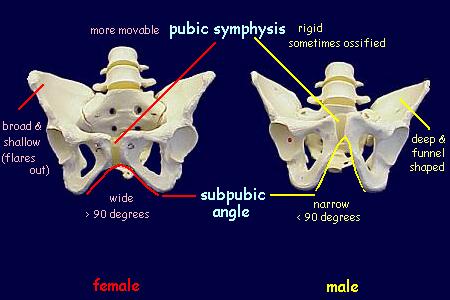
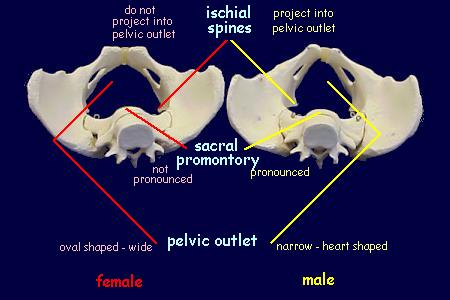
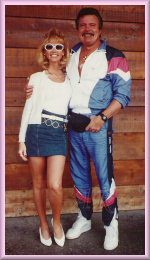
Born a boy, former Las Vegas showgirl
Jahna Steele
had the small and slight skeletal build common in women, but very rare in men.
|
Long Bones and other Bones
In the adult skeleton, the long bones in the legs and arms can be examined and differences in the diameter of the humeral head, femoral head, and bicondylar breadth used for sex determination, and sites of attachment for the deltoid and hamstring muscles analyzed for degree of robusticity. Interestingly, and rather unexpectedly, the average female upper arm bone (humerus) is 1" (2.5 cm) longer than the male upper arm - making it one of the most visually obvious signs of a male or female to an informed observer. The short upper arm makes it easier for males to throw footballs and lift heavy objects (less moment arm), the longer upper arm makes it easier for females to hold and suckle babies.
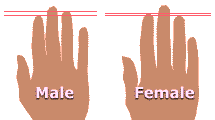
Finger length ratio has become a widely known form of sex differentiation. Most men have an index finger (digit 2, or 2D) shorter than their ring finger (digit 4, or 4D), whilst most women have an index finger that is as long or longer than their ring finger. Significant deviation from a 2D to 4D ratio of 0.98:1 ratio is a
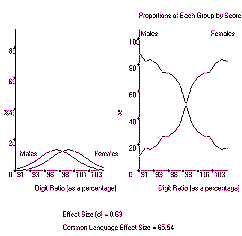
fairly strong indicator of natal sex.
|
It's believed that the difference in finger length is due to the action of "male" androgen hormones on the skeleton of a developing fetus. This seems to be confirmed by the fact that suffers of
Androgen Insensitivity Syndrome
(who are genetically XY male, but not affected by Androgen) often have a statistically female digit ratio, whilst women who suffer from congenital adrenal hyperplasia (which raises their androgen levels before birth) often have a statistically male ratio.
|

A young transsexual woman. On initial impressions her petite frame indicates female, but her large hands and longer ring finger give a strong hint.
 Patrícia Araújo (born Felipe Silva de Araújo) shows off legs that have made her a top female model in Brazil.
Patrícia Araújo (born Felipe Silva de Araújo) shows off legs that have made her a top female model in Brazil.
Skeletal Feature
|
|
Male
|
Female
|
|
LEGS
|
Femur bone
:
| Trochanteric oblique length |
|
|
ARMS
|
Humerus bone
:
|
|
FINGERS
|
BONES (GENERALLY)
|
Bone weight is :
|
heavier
|
lighter
|
Bone markings :
|
more prominent
|
less prominent
|
|
Measurements
|
Female
|
Probably
Female
|
Indefinite
sex
|
Probably
male
|
Male
|
Diameter of
head of femur (mm)
|
|
<41.5
|
41.5 to 43.5
|
43.5 to 44.5
|
44.5 to 45.5
|
>45.5
|
Trochanteric oblique length (mm)
|
<390
|
390 to 405
|
405 to 430
|
430 to 450
|
>450
|
Height
Height is a good indicator of sex, although a rapid in increase in height over the 50 years due to better nutrient has confused the statistics and age based percentiles. The following table indicates some examples of the differentiation between average male and female heights in surveys taken since 2003:
Country
|
Age Group
|
Average Male Height
|
Average Female Height
|
Ratio
|
U.K.
–
England
|
16+
|
1.754 m (5 ft 9 in)
|
1.619 m (5 ft 3 1⁄2 in)
|
1.08
|
U.K. –
England
|
16–24
|
1.771 m (5 ft 9 1⁄2 in)
|
1.644 m (5 ft 4 1⁄2 in)
|
1.08
|
U.K.
–
England
|
25–34
|
1.776 m (5 ft 10 in)
|
1.637 m (5 ft 4 1⁄2 in)
|
1.08
|
U.K.
–
Scotland
|
16+
|
1.750 m (5 ft 9 in)
|
1.613 m (5 ft 3 1⁄2 in)
|
1.08
|
U.K.
–
Scotland
|
25–34
|
1.782 m (5 ft 10 in)
|
1.635 m (5 ft 4 1⁄2 in)
|
1.09
|
U.K.
–
Wales
|
16+
|
1.770 m (5 ft 9 1⁄2 in)
|
1.620 m (5 ft 4 in)
|
1.09
|
U.S.
|
All Americans, 20–29
|
1.776 m (5 ft 10 in)
|
1.632 m (5 ft 4 1⁄2 in)
|
1.09
|
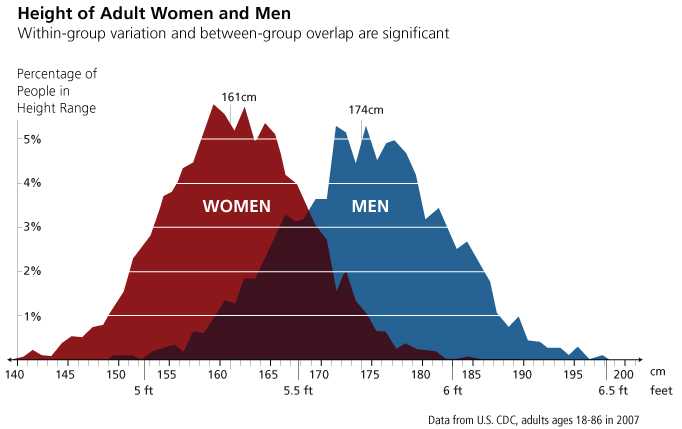
Summary
|
There is no definite 100% way of distinguishing a male from a female skeleton, but here is a list of the major criteria to be considered.
Male
|
|
Female
|

 Penny Clifford had SRS at about 31 - below the average age for a westerner. However while obviously a very attractive woman, the lower picture shows the physical problems that face most adult transsexuals due to their already masculinized skeleton.
Penny Clifford had SRS at about 31 - below the average age for a westerner. However while obviously a very attractive woman, the lower picture shows the physical problems that face most adult transsexuals due to their already masculinized skeleton.
Height is greater* (average 5ft 10 in)
|
Height is lower* (average 5ft 4in)
|
Skull is heavy and rough
|
Lighter and smoother
|
Forehead is usually sloping
|
More vertical
|
Sinuses are large
|
Smaller
|
Cranium is large
|
Smaller (by about 10%)
|
Mandible is large and robust
|
Lighter and smaller
|
Teeth are large
|
Smaller
|
Upper arm is short
|
Upper arm is long
|
Ring finger longer than index finger
|
Ring finger shorter than index finger
|
PELVIS
|
|
Narrow, robust, heavy, rough
|
|
Broad, light, smooth
|
Pelvic inlet is heart shaped
|
Oval to round shape
|
Iliac fossa is deep
|
Relatively shallow
|
Ilium extends further above the sacrum
|
More vertical, lessabove the sacroiliac
|
Angle under the symphysis is usually much less than 90 degrees
|
Angle is often greater than 100 degrees
|
Sacrum is long, with a pronounced sacral curvature
|
Broad, short less curvature
|
Coccyx points anteriorly
|
Points inferiorly
|
Bone weight is heavy
|
Lighter
|
Bone markings are prominent
|
Less prominent
|
* Average adult height in the "West", amazingly these figures have increased by over an inch since World War 2, and two inches compared to pre-1900.
|

Tonya, her very female appearance is the result of many years of hormones and a lot of expensive surgery
|
Surgical Feminization of the Male Skeleton
|
You may now want to read the
article
on this site about
feminisation surgery
on the genetic male.
Height Analysis
I used to include a link here to a Java applet for comparing your height against male and female averages. For example, at 5ft 9inches I was boringly average as a man, but apparently only 3% of women were taller - which was slightly hard to believe given all the women that seemed to tower over me every day!
Copyright (c) 2012, Annie Richards
Last updated: 22 January, 2012







 Measurements of weight and height have little overlap between male and female skeletons, and thus can distinguish between men and women with a 90% success rate. Transsexual women would generally be identified as men on these criteria. (Sample sets of 125 men and 138 women are illustrated)
Measurements of weight and height have little overlap between male and female skeletons, and thus can distinguish between men and women with a 90% success rate. Transsexual women would generally be identified as men on these criteria. (Sample sets of 125 men and 138 women are illustrated)

















 Patrícia Araújo (born Felipe Silva de Araújo) shows off legs that have made her a top female model in Brazil.
Patrícia Araújo (born Felipe Silva de Araújo) shows off legs that have made her a top female model in Brazil. 

 Penny Clifford had SRS at about 31 - below the average age for a westerner. However while obviously a very attractive woman, the lower picture shows the physical problems that face most adult transsexuals due to their already masculinized skeleton.
Penny Clifford had SRS at about 31 - below the average age for a westerner. However while obviously a very attractive woman, the lower picture shows the physical problems that face most adult transsexuals due to their already masculinized skeleton.
